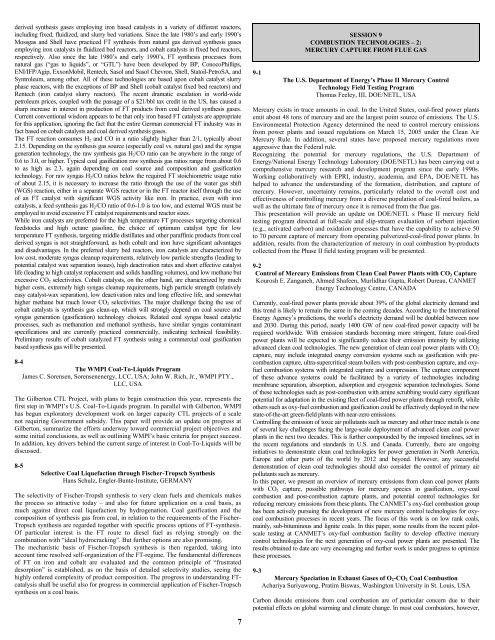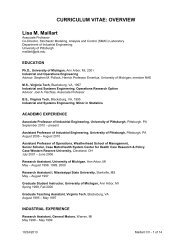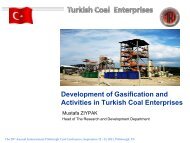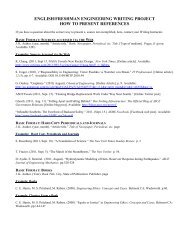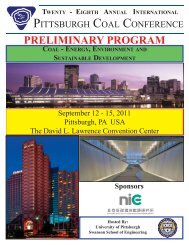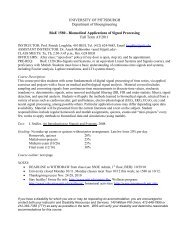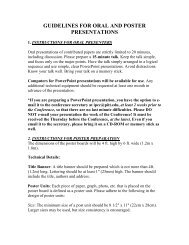Abstract Booklet 2006 - Swanson School of Engineering - University ...
Abstract Booklet 2006 - Swanson School of Engineering - University ...
Abstract Booklet 2006 - Swanson School of Engineering - University ...
You also want an ePaper? Increase the reach of your titles
YUMPU automatically turns print PDFs into web optimized ePapers that Google loves.
derived synthesis gases employing iron based catalysts in a variety <strong>of</strong> different reactors,<br />
including fixed, fluidized, and slurry bed variations. Since the late 1980’s and early 1990’s<br />
Mossgas and Shell have practiced FT synthesis from natural gas derived synthesis gases<br />
employing iron catalysts in fluidized bed reactors, and cobalt catalysts in fixed bed reactors,<br />
respectively. Also since the late 1980’s and early 1990’s, FT synthesis processes from<br />
natural gas (“gas to liquids”, or “GTL”) have been developed by BP, ConocoPhillips,<br />
ENI/IFP/Agip, ExxonMobil, Rentech, Sasol and Sasol Chevron, Shell, Statoil-PetroSA, and<br />
Syntroleum, among other. All <strong>of</strong> these technologies are based upon cobalt catalyst slurry<br />
phase reactors, with the exceptions <strong>of</strong> BP and Shell (cobalt catalyst fixed bed reactors) and<br />
Rentech (iron catalyst slurry reactors). The recent dramatic escalation in world-wide<br />
petroleum prices, coupled with the passage <strong>of</strong> a $21/bbl tax credit in the US, has caused a<br />
sharp increase in interest in production <strong>of</strong> FT products from coal derived synthesis gases.<br />
Current conventional wisdom appears to be that only iron based FT catalysts are appropriate<br />
for this application, ignoring the fact that the entire German commercial FT industry was in<br />
fact based on cobalt catalysts and coal derived synthesis gases.<br />
The FT reaction consumes H 2 and CO in a ratio slightly higher than 2/1, typically about<br />
2.15. Depending on the synthesis gas source (especially coal vs. natural gas) and the syngas<br />
generation technology, the raw synthesis gas H 2 /CO ratio can be anywhere in the range <strong>of</strong><br />
0.6 to 3.0, or higher. Typical coal gasification raw synthesis gas ratios range from about 0.6<br />
to as high as 2.3, again depending on coal source and composition and gasification<br />
technology. For raw syngas H 2 /CO ratios below the required FT stoichiometric usage ratio<br />
<strong>of</strong> about 2.15, it is necessary to increase the ratio through the use <strong>of</strong> the water gas shift<br />
(WGS) reaction, either in a separate WGS reactor or in the FT reactor itself through the use<br />
<strong>of</strong> an FT catalyst with significant WGS activity like iron. In practice, even with iron<br />
catalysts, a feed synthesis gas H 2 /CO ratio <strong>of</strong> 0.6-1.0 is too low, and external WGS must be<br />
employed to avoid excessive FT catalyst requirements and reactor sizes.<br />
While iron catalysts are preferred for the high temperature FT processes targeting chemical<br />
feedstocks and high octane gasoline, the choice <strong>of</strong> optimum catalyst type for low<br />
temperature FT synthesis, targeting middle distillates and other paraffinic products from coal<br />
derived syngas is not straightforward, as both cobalt and iron have significant advantages<br />
and disadvantages. In the preferred slurry bed reactors, iron catalysts are characterized by<br />
low cost, moderate syngas cleanup requirements, relatively low particle strengths (leading to<br />
potential catalyst wax separation issues), high deactivation rates and short effective catalyst<br />
life (leading to high catalyst replacement and solids handling volumes), and low methane but<br />
excessive CO 2 selectivities. Cobalt catalysts, on the other hand, are characterized by much<br />
higher costs, extremely high syngas cleanup requirements, high particle strength (relatively<br />
easy catalyst-wax separation), low deactivation rates and long effective life, and somewhat<br />
higher methane but much lower CO 2 selectivities. The major challenge facing the use <strong>of</strong><br />
cobalt catalysts is synthesis gas clean-up, which will strongly depend on coal source and<br />
syngas generation (gasification) technology choices. Related coal syngas based catalytic<br />
processes, such as methanation and methanol synthesis, have similar syngas contaminant<br />
specifications and are currently practiced commercially, indicating technical feasibility.<br />
Preliminary results <strong>of</strong> cobalt catalyzed FT synthesis using a commercial coal gasification<br />
based synthesis gas will be presented.<br />
8-4<br />
The WMPI Coal-To-Liquids Program<br />
James C. Sorensen, Sorensenenergy, LCC, USA; John W. Rich, Jr., WMPI PTY.,<br />
LLC, USA<br />
The Gilberton CTL Project, with plans to begin construction this year, represents the<br />
first step in WMPI’s U.S. Coal-To-Liquids program. In parallel with Gilberton, WMPI<br />
has begun exploratory development work on larger capacity CTL projects <strong>of</strong> a scale<br />
not requiring Government subsidy. This paper will provide an update on progress at<br />
Gilberton, summarize the efforts underway toward commercial project objectives and<br />
some initial conclusions, as well as outlining WMPI’s basic criteria for project success.<br />
In addition, key drivers behind the current surge <strong>of</strong> interest in Coal-To-Liquids will be<br />
discussed.<br />
8-5<br />
Selective Coal Liquefaction through Fischer-Tropsch Synthesis<br />
Hans Schulz, Engler-Bunte-Institute, GERMANY<br />
The selectivity <strong>of</strong> Fischer-Tropsh synthesis to very clean fuels and chemicals makes<br />
the process so attractive today – and also for future application on a coal basis, as<br />
much against direct coal liquefaction by hydrogenation. Coal gasification and the<br />
composition <strong>of</strong> synthesis gas from coal, in relation to the requirements <strong>of</strong> the Fischer-<br />
Tropsch synthesis are regarded together with specific process options <strong>of</strong> FT-synthesis.<br />
Of particular interest is the FT route to diesel fuel as relying strongly on the<br />
combination with “ideal hydrocracking”. But further options are also promising.<br />
The mechanistic basis <strong>of</strong> Fischer-Tropsch synthesis is then regarded, taking into<br />
account time resolved self-organization <strong>of</strong> the FT-regime. The fundamental differences<br />
<strong>of</strong> FT on iron and cobalt are evaluated and the common principle <strong>of</strong> “frustrated<br />
desorption” is established, as on the basis <strong>of</strong> detailed selectivity studies, seeing the<br />
highly ordered complexity <strong>of</strong> product composition. The progress in understanding FTcatalysis<br />
shall be useful also for progress in commercial application <strong>of</strong> Fischer-Tropsch<br />
synthesis on a coal basis.<br />
7<br />
9-1<br />
SESSION 9<br />
COMBUSTION TECHNOLOGIES – 2:<br />
MERCURY CAPTURE FROM FLUE GAS<br />
The U.S. Department <strong>of</strong> Energy’s Phase II Mercury Control<br />
Technology Field Testing Program<br />
Thomas Feeley, III, DOE/NETL, USA<br />
Mercury exists in trace amounts in coal. In the United States, coal-fired power plants<br />
emit about 48 tons <strong>of</strong> mercury and are the largest point source <strong>of</strong> emissions. The U.S.<br />
Environmental Protection Agency determined the need to control mercury emissions<br />
from power plants and issued regulations on March 15, 2005 under the Clean Air<br />
Mercury Rule. In addition, several states have proposed mercury regulations more<br />
aggressive than the Federal rule.<br />
Recognizing the potential for mercury regulations, the U.S. Department <strong>of</strong><br />
Energy/National Energy Technology Laboratory (DOE/NETL) has been carrying out a<br />
comprehensive mercury research and development program since the early 1990s.<br />
Working collaboratively with EPRI, industry, academia, and EPA, DOE/NETL has<br />
helped to advance the understanding <strong>of</strong> the formation, distribution, and capture <strong>of</strong><br />
mercury. However, uncertainty remains, particularly related to the overall cost and<br />
effectiveness <strong>of</strong> controlling mercury from a diverse population <strong>of</strong> coal-fired boilers, as<br />
well as the ultimate fate <strong>of</strong> mercury once it is removed from the flue gas.<br />
This presentation will provide an update on DOE/NETL s Phase II mercury field<br />
testing program directed at full-scale and slip-stream evaluation <strong>of</strong> sorbent injection<br />
(e.g., activated carbon) and oxidation processes that have the capability to achieve 50<br />
to 70 percent capture <strong>of</strong> mercury from operating pulverized-coal-fired power plants. In<br />
addition, results from the characterization <strong>of</strong> mercury in coal combustion by-products<br />
collected from the Phase II field testing program will be presented.<br />
9-2<br />
Control <strong>of</strong> Mercury Emissions from Clean Coal Power Plants with CO 2 Capture<br />
Kourosh E. Zanganeh, Ahmed Shafeen, Murlidhar Gupta, Robert Dureau, CANMET<br />
Energy Technology Centre, CANADA<br />
Currently, coal-fired power plants provide about 39% <strong>of</strong> the global electricity demand and<br />
this trend is likely to remain the same in the coming decades. According to the International<br />
Energy Agency’s predictions, the world’s electricity demand will be doubled between now<br />
and 2030. During this period, nearly 1400 GW <strong>of</strong> new coal-fired power capacity will be<br />
required worldwide. With emission standards becoming more stringent, future coal-fired<br />
power plants will be expected to significantly reduce their emission intensity by utilizing<br />
advanced clean coal technologies. The new generation <strong>of</strong> clean coal power plants with CO 2<br />
capture, may include integrated energy conversion systems such as gasification with precombustion<br />
capture, ultra-supercritical steam boilers with post-combustion capture, and oxyfuel<br />
combustion systems with integrated capture and compression. The capture component<br />
<strong>of</strong> these advance systems could be facilitated by a variety <strong>of</strong> technologies including<br />
membrane separation, absorption, adsorption and cryogenic separation technologies. Some<br />
<strong>of</strong> these technologies such as post-combustion with amine scrubbing would carry significant<br />
potential for adaptation in the existing fleet <strong>of</strong> coal-fired power plants through retr<strong>of</strong>it, while<br />
others such as oxy-fuel combustion and gasification could be effectively deployed in the new<br />
state-<strong>of</strong>-the-art green-field plants with near-zero emissions.<br />
Controlling the emission <strong>of</strong> toxic air pollutants such as mercury and other trace metals is one<br />
<strong>of</strong> several key challenges facing the large-scale deployment <strong>of</strong> advanced clean coal power<br />
plants in the next two decades. This is further compounded by the imposed timelines, set in<br />
the recent regulations and standards in U.S. and Canada. Currently, there are ongoing<br />
initiatives to demonstrate clean coal technologies for power generation in North America,<br />
Europe and other parts <strong>of</strong> the world by 2012 and beyond. However, any successful<br />
demonstration <strong>of</strong> clean coal technologies should also consider the control <strong>of</strong> primary air<br />
pollutants such as mercury.<br />
In this paper, we present an overview <strong>of</strong> mercury emissions from clean coal power plants<br />
with CO 2 capture, possible pathways for mercury species in gasification, oxy-coal<br />
combustion and post-combustion capture plants, and potential control technologies for<br />
reducing mercury emissions from these plants. The CANMET’s oxy-fuel combustion group<br />
has been actively pursuing the development <strong>of</strong> new mercury control technologies for oxycoal<br />
combustion processes in recent years. The focus <strong>of</strong> this work is on low rank coals,<br />
mainly, sub-bituminous and lignite coals. In this paper, some results from the recent pilotscale<br />
testing at CANMET’s oxy-fuel combustion facility to develop effective mercury<br />
control technologies for the next generation <strong>of</strong> oxy-coal power plants are presented. The<br />
results obtained to date are very encouraging and further work is under progress to optimize<br />
these processes.<br />
9-3<br />
Mercury Speciation in Exhaust Gases <strong>of</strong> O 2 -CO 2 Coal Combustion<br />
Achariya Suriyawong, Pratim Biswas, Washington <strong>University</strong> in St. Louis, USA<br />
Carbon dioxide emissions from coal combustion are <strong>of</strong> particular concern due to their<br />
potential effects on global warming and climate change. In most coal combustors, however,


